Contents
The API Gateway can use the OAuth 2.0 protocol for authentication and authorization. The API Gateway can act as an OAuth 2.0 Authorization Server and supports several OAuth 2.0 flows that cover common Web server, JavaScript, device, installed application, and server-to-server scenarios. This topic describes each of the supported OAuth 2.0 flows in detail, and shows how to run example client applications.
The Authorization Code or Web server flow is suitable for clients that can interact with the end-user’s user-agent (typically a Web browser), and that can receive incoming requests from the authorization server (can act as an HTTP server). The Authorization Code flow is also known as the Three-Legged OAuth flow.
The Authorization Code flow is as follows:
-
The Web server redirects the user to the API Gateway acting as an Authorization Server to authenticate and authorize the server to access data on their behalf.
-
After the user approves access, the Web server receives a callback with an authorization code.
-
After obtaining the authorization code, the Web server passes back the authorization code to obtain an access token response.
-
After validating the authorization code, the API Gateway passes back a token response to the Web server.
-
After the token is granted, the Web server accesses their data.
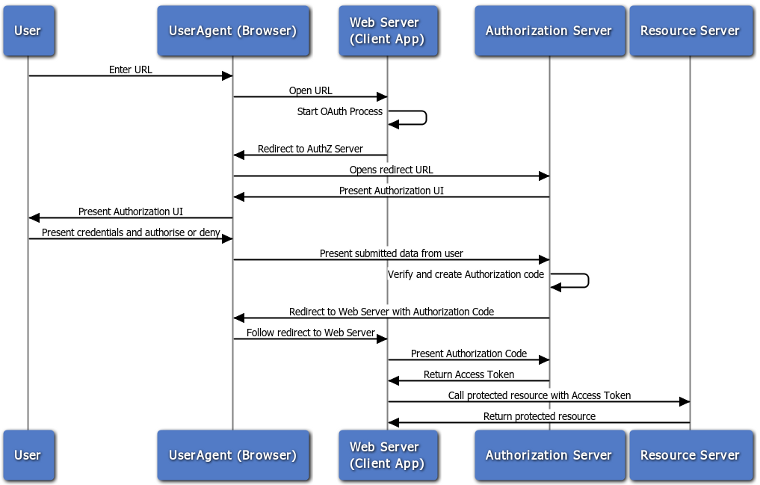
Obtaining an access token
The detailed steps for obtaining an access token are as follows:
1. Redirect the user to the authorization endpoint with the following parameters:
| Parameter | Description |
|---|---|
|
|
Required. Must be set to |
|
|
Required. The Client ID generated when the application was registered in the Oracle Client Application Registry. |
|
|
Optional. Where the authorization code will be sent. This value must match one of the values provided in the Oracle Client Application Registry. |
|
|
Optional. A space delimited list of scopes, which indicate the access to the Resource Owner's data being requested by the application. |
|
|
Optional. Any state the consumer wants reflected back to it after approval during the callback. |
The following is an example URL:
https://apigateway/oauth/authorize?client_id=SampleConfidentialApp&
response_type=code&&redirect_uri=http%3A%2F%2Flocalhost%3A8090%2Fauth%2Fredirect.html&
scope=https%3A%2F%2Flocalhost%3A8090%2Fauth%2Fuserinfo.email
![[Note]](../common_oracle/images/admon/note.png) |
Note |
|---|---|
|
During this step the Resource Owner user must approve access for the application Web server to access their protected resources, as shown in the following example screen. |
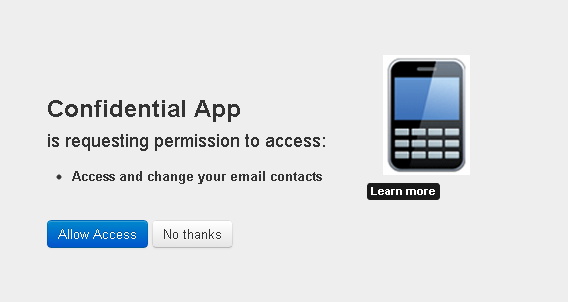
2. The response to the above request is sent to the redirect_uri.
If the user approves the access request, the response contains an authorization code
and the state parameter (if included in the request). If the user does
not approve the request, the response contains an error message. All responses are
returned to the Web server on the query string. For example:
https://localhost/oauth_callback&code=9srN6sqmjrvG5bWvNB42PCGju0TFVV
3. After the Web server receives the authorization code, it may exchange the authorization
code for an access token and a refresh token. This request is an HTTPS POST,
and includes the following parameters:
| Parameter | Description |
|---|---|
|
|
Required. Must be set to |
|
|
Required. The authorization code received in the redirect above. |
|
|
Required. The redirect URL registered for the application during application registration. |
|
|
Optional. The |
|
|
Optional. The |
|
|
Optional. Expected return format. The default is
|
* If the client_id and client_secret are not
provided as parameters in the HTTP POST, they must be provided in the HTTP
Basic Authentication header (Authorization base64Encoded(client_id:client_secret)).
The following example HTTPS POST shows some parameters:
POST /api/oauth/token HTTP/1.1 Content-Type: application/x-www-form-urlencoded client_id=SampleConfidentialApp&client_secret=6808d4b6-ef09-4b0d-8f28-3b05da9c48ec &code=9srN6sqmjrvG5bWvNB42PCGju0TFVV&redirect_uri=http%3A%2F%2Flocalhost%3A809 0%2Fauth%2Fredirect.html&grant_type=authorization_code&format=query
4. After the request is verified, the API Gateway sends a response to the client. The following parameters are in the response body:
| Parameter | Description |
|---|---|
|
|
The token that can be sent to the Resource Server to access the protected resources of the Resource Owner (user). |
|
|
A token that may be used to obtain a new access token. |
|
|
The remaining lifetime on the access token. |
|
|
Indicates the type of token returned. At this time, this field
always has a value of |
The following is an example response:
HTTP/1.1 200 OK
Cache-Control: no-store
Content-Type: application/json
Pragma: no-cache{
"access_token": “O91G451HZ0V83opz6udiSEjchPynd2Ss9......",
"token_type": "Bearer",
"expires_in": "3600",
}
5. After the Web server has obtained an access token, it can gain access to
protected resources on the Resource Server by placing it in an
Authorization: Bearer HTTP header:
GET /oauth/protected HTTP/1.1 Authorization: Bearer O91G451HZ0V83opz6udiSEjchPynd2Ss9 Host: apigateway.com
For example, the curl command to call a protected resource with
an access token is as follows:
curl -H "Authorization: Bearer O91G451HZ0V83opz6udiSEjchPynd2Ss9" https://apigateway.com/oauth/protected
Running the sample client
The following Jython sample client creates and sends an authorization request for the authorization grant flow to the Authorization Server:
INSTALL_DIR/samples/scripts/oauth/authorization_code.py
To run the sample, perform the following steps:
-
Open a shell prompt at
INSTALL_DIR/samples/scripts, and execute the following command:> run oauth/authorization_code.py
The script outputs the following:
> Go to the URL here: http://127.0.0.1:8080/api/oauth/authorize?client_id=SampleConfidentialApp &response_type=code&scope=https%3A%2F%2Flocalhost%3A8090%2Fauth%2Fuserinfo.email &redirect_uri=https%3A%2F%2Flocalhost%2Foauth_callback Enter Authorization code in dialog
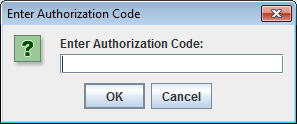
-
Copy the URL output to the command prompt into a browser, and perform the following steps as prompted:
-
Provide login credentials to the authorization server. The default values are:
-
Username:
admin -
Password:
changeme
-
-
When prompted, grant access to the client application to access the protected resource.
-
-
After the Resource Owner has authorized and approved access to the application, the Authorization Server redirects a fragment containing the authorization code to the redirection URI. For example:
https://localhost/oauth_callback&code=AaI5Or3RYB2uOgiyqVsLs1ATIY0ll0
In this example, the authorization code is:
AaI5Or3RYB2uOgiyqVsLs1ATIY0ll0
Enter this value into the Enter Authorization Code dialog. The script will exchange the authorization code for an access token, and then access the protected resource using the access token. For example:
Enter Authorization code in dialog AuthZ code: AaI5Or3RYB2uOgiyqVsLs1ATIY0ll0 Exchange authZ code for access token Sending up access token request using grant_type set to authorization_code Response from access token request: 200 Parsing the json response **********************ACCESS TOKEN RESPONSE*********************************** Access token received from authorization server icPgKP2uVUD2thvAZ5ENhsQb66ffnZEC XHyRQEz5zP8aGzcobLV3AR Access token type received from authorization server Bearer Access token expiry time: 3599 Refresh token: NpNbzIVVvj8MhMmcWx2zsawxxJ3YADfc0XIxlZvw0tIhh8 ****************************************************************************** Now we can try access the protected resource using the access token Executing get request on the protected url Response from protected resource request is: 200 <html>Congrats! You've hit an OAuth protected resource</html>
Further information
For details on API Gateway filters that support this flow, see the following topics:
The Implicit Grant (User-Agent) authentication flow is used by client applications (consumers) residing in the user's device. This could be implemented in a browser using a scripting language such as JavaScript, or from a mobile device or a desktop application. These consumers cannot keep the client secret confidential (application password or private key).
The User Agent flow is as follows:
-
The Web server redirects the user to the API Gateway acting as an Authorization Server to authenticate and authorize the server to access data on their behalf.
-
After the user approves access, the Web server receives a callback with an access token in the fragment of the redirect URL.
-
After the token is granted, the application can access the protected data with the access token.

Obtaining an access token
The detailed steps for obtaining an access token are as follows:
1. Redirect the user to the authorization endpoint with the following parameters:
| Parameter | Description |
|---|---|
|
|
Required. Must be set to token. |
|
|
Required. The Client ID generated when the application was registered in the Oracle Client Application Registry. |
|
|
Optional. Where the access token will be sent. This value must match one of the values provided in the Oracle Client Application Registry. |
|
|
Optional. A space delimited list of scopes, which indicates the access to the Resource Owner's data requested by the application. |
|
|
Optional. Any state the consumer wants reflected back to it after approval during the callback. |
The following is an example URL:
https://apigateway/oauth/authorize?client_id=SampleConfidentialApp&response_type= token&&redirect_uri=http%3A%2F%2Flocalhost%3A8090%2Fauth%2Fredirect.html&scope= https%3A%2F%2Flocalhost%3A8090%2Fauth%2Fuserinfo.email
![[Note]](../common_oracle/images/admon/note.png) |
Note |
|---|---|
|
During this step the Resource Owner user must approve access for the application (Web server) to access their protected resources, as shown in the following example screen. |

2. The response to the above request is sent to the redirect_uri.
If the user approves the access request, the response contains an access token
and the state parameter (if included in the request). For example:
https://localhost/oauth_callback#access_token=19437jhj2781FQd44AzqT3Zg &token_type=Bearer&expires_in=3600
If the user does not approve the request, the response contains an error message.
3. After the request is verified, the API Gateway sends a response to the client. The following parameters are contained in the fragment of the redirect:
| Parameter | Description |
|---|---|
|
|
The token that can be sent to the Resource Server to access the protected resources of the Resource Owner (user). |
|
|
The remaining lifetime on the access token. |
|
|
Indicates the type of token returned. At this time, this
field will always have a value of |
|
|
Optional. If the client application sent a value for state in the original authorization request, the state parameter is populated with this value. |
4. After the application has obtained an access token, it can gain access to
protected resources on the Resource Server by placing it in an Authorization:
Bearer HTTP header:
GET /oauth/protected HTTP/1.1 Authorization: Bearer O91G451HZ0V83opz6udiSEjchPynd2Ss9 Host: apigateway.com
For example, the curl command to call a protected resource with an
access token is as follows:
curl -H "Authorization: Bearer O91G451HZ0V83opz6udiSEjchPynd2Ss9" https://apigateway.com/oauth/protected
Running the sample client
The following Jython sample client creates and sends an authorization request for the implicit grant flow to the Authorization Server:
INSTALL_DIR/samples/scripts/oauth/implicit_grant.py
To run the sample, perform the following steps:
-
Open a shell prompt at
INSTALL_DIR/samples/scripts, and execute the following command:> run oauth/implicit_grant.py
The script outputs the following:
> Go to the URL here: http://127.0.0.1:8080/api/oauth/authorize?client_id=SampleConfidentialApp& response_type=token&scope=https%3A%2F%2Flocalhost%3A8090%2Fauth%2Fuserinfo.email& redirect_uri=https%3A%2F%2Flocalhost%2Foauth_callback&state=1956901292 Enter Access Token code in dialog
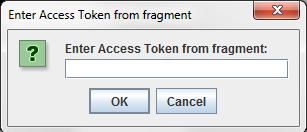
-
After the Resource Owner has authorized and approved access to the application, the Authorization Server redirects to the redirection URI a fragment containing the access token. For example:
https://localhost/oauth_callback#access_token= 4owzGyokzLLQB5FH4tOMk7Eqf1wqYfENEDXZ1mGvN7u7a2Xexy2OU9&expires_in= 3599&state=1956901292&token_type=Bearer
In this example, the access token is:
4owzGyokzLLQB5FH4tOMk7Eqf1wqYfENEDXZ1mGvN7u7a2Xexy2OU9
Enter this value into the Enter Access Token from fragment dialog, and the script attempts to access the protected resource using the access token. For example:
**********************ACCESS TOKEN RESPONSE****************************** Access token received from authorization server 4owzGyokzLLQB5FH4tOMk7Eqf1wqYfEN EDXZ1mGvN7u7a2Xexy2OU9 ****************************************************************************** Now we can try access the protected resource using the access token Executing get request on the protected url Response from protected resource request is: 200 <html>Congrats! You've hit an OAuth protected resource</html>
Further information
For details on the API Gateway filter that supports this flow, see the Authorization Code Flow filter.
The Resource Owner password credentials flow is also known as the username-password authentication flow. This flow can be used as a replacement for an existing login when the consumer already has the user’s credentials.
The Resource Owner password credentials grant type is suitable in cases where the Resource Owner has a trust relationship with the client (for example, the device operating system or a highly privileged application). The Authorization Server should take special care when enabling this grant type, and only allow it when other flows are not viable.
This grant type is suitable for clients capable of obtaining the Resource Owner's credentials (username and password, typically using an interactive form). It is also used to migrate existing clients using direct authentication schemes such as HTTP Basic or Digest authentication to OAuth by converting the stored credentials to an access token.

Requesting an access token
The client token request should be sent in an HTTP POST to the
token endpoint with the following parameters:
| Parameter | Description |
|---|---|
|
|
Required. Must be set to |
|
|
Required. The Resource Owner's user name. |
|
|
Required. The Resource Owner's password. |
|
|
Optional. The scope of the authorization. |
|
|
Optional. Expected return format. The default is
|
The following is an example HTTP POST request:
POST /api/oauth/token HTTP/1.1 Content-Length: 424 Content-Type: application/x-www-form-urlencoded; charset=UTF-8 Host: 192.168.0.48:8080 Authorization: Basic czZCaGRSa3F0MzpnWDFmQmF0M2JWgrant_type=password&username= johndoe&password=A3ddj3w
Handling the response
The API Gateway will validate the resource owner’s credentials and authenticate the client against the Oracle Client Application Registry. An access token, and optional refresh token, is sent back to the client on success. For example, a valid response is as follows:
HTTP/1.1 200 OK
Cache-Control: no-store
Content-Type: application/json
Pragma: no-cache
{
"access_token": “O91G451HZ0V83opz6udiSEjchPynd2Ss9......",
"token_type": "Bearer",
"expires_in": "3600",
“refresh_token”: “8722gffy2229220002iuueee7GP...........”
}Running the sample client
The following Jython sample client sends a request to the Authorization Server using the Resource Owner password credentials flow:
INSTALL_DIR/samples/scripts/oauth/resourceowner_password_credentials.py
To run the sample, open a shell prompt at INSTALL_DIR/samples/scripts, and execute
the following command:
> run oauth/resourceowner_password_credentials.py
The script outputs the following:
Sending up access token request using grant_type set to password Response from access token request: 200 Parsing the json response **********************ACCESS TOKEN RESPONSE*********************************** Access token received from authorization server lrGHhFhFwSmycXStIza1jjvXlSaac9 JNIgviF7oPiV8OnxlSIsrxVA Access token type received from authorization server Bearer Access token expiry time: 3600 ****************************************************************************** Now we can try access the protected resource using the access token Executing get request on the protected url Response from protected resource request is: 200 <html>Congrats! You've hit an OAuth protected resource</html>
Further information
For details on the API Gateway filter that supports this flow, see Resource Owner Credentials.
The client credentials grant type must only be used by confidential clients. The client can request an access token using only its client credentials (or other supported means of authentication) when the client is requesting access to the protected resources under its control. The client can also request access to those of another Resource Owner that has been previously arranged with the Authorization Server (the method of which is beyond the scope of the specification).

Requesting an access token
The client token request should be sent in an HTTP POST to the token
endpoint with the following parameters:
| Parameter | Description |
|---|---|
|
|
Required. Must be set to |
|
|
Optional. The scope of the authorization. |
|
|
Optional. Expected return format. The default is
|
The following is an example POST request:
POST /api/oauth/token HTTP/1.1 Content-Length: 424 Content-Type: application/x-www-form-urlencoded; charset=UTF-8 Host: 192.168.0.48:8080 Authorization: Basic czZCaGRSa3F0MzpnWDFmQmF0M2JW grant_type=client_credentials
Handling the response
The API Gateway authenticates the client against the Oracle Client Application Registry. An access token is sent back to the client on success. A refresh token is not included in this flow. An example valid response is as follows:
HTTP/1.1 200 OK
Cache-Control: no-store
Content-Type: application/json
Pragma: no-cache
{ "access_token": “O91G451HZ0V83opz6udiSEjchPynd2Ss9......",
"token_type": "Bearer",
"expires_in": "3600"
}
Running the sample client
The following Jython sample client sends a request to the Authorization Server using the client credentials flow:
INSTALL_DIR/samples/scripts/oauth/client_credentials.py
To run the sample, open a shell prompt at INSTALL_DIR/samples/scripts,
and execute the following command:
> run oauth/client_credentials.py
The outputs the following:
Sending up access token request using grant_type set to client_credentials Response from access token request: 200 Parsing the json response **********************ACCESS TOKEN RESPONSE*********************************** Access token received from authorization server OjtVvNusLg2ujy3a6IXHhavqdEPtK7qSmIj9fLl8qywPyX8bKEsjqF Access token type received from authorization server Bearer Access token expiry time: 3599 ****************************************************************************** Now we can try access the protected resource using the access token Response from protected resource request is: 200 <html>Congrats! You've hit an OAuth protected resource</html>
Further information
For details on the API Gateway filter that supports this flow, see Access Token Using Client Credentials.
A JSON Web Token (JWT) is a JSON-based security token encoding that enables identity and security information to be shared across security domains.
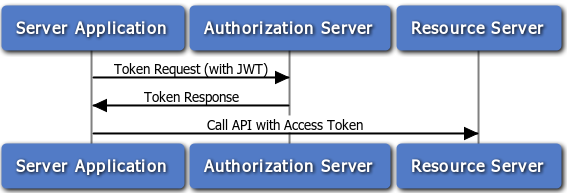
In the OAuth 2.0 JWT flow, the client application is assumed to be a confidential client that can store the client application’s private key. The X.509 certificate that matches the client’s private key must be registered in the Oracle Client Application Registry. The API Gateway uses this certificate to verify the signature of the JWT claim. For information on creating a private key and certificate, see the section called “Generating a Certificate and Private Key for a Client Application”.
For more details on the OAuth 2.0 JWT flow, see
http://self-issued.info/docs/draft-ietf-oauth-jwt-bearer-00.html
Creating a JWT bearer token
To create a JWT bearer token, perform the following steps:
-
Construct a JWT header in the following format:
{"alg":"RS256"} -
Base64url encode the JWT Header as defined here, which results in the following:
eyJhbGciOiJSUzI1NiJ9
-
Create a JWT Claims Set, which conforms to the following rules:
For example:-
The issuer (
iss) must be the OAuthclient_idor the remote access application for which the developer registered their certificate. -
The audience (
aud) must match the value configured in the JWT filter. By default, this value is as follows:http://apigateway/api/oauth/token -
The validity (
exp) must be the expiration time of the assertion, within five minutes, expressed as the number of seconds from1970-01-01T0:0:0Zmeasured in UTC. -
The time the assertion was issued (
iat) measured in seconds after00:00:00UTC, January 1, 1970. -
The JWT must be signed (using RSA SHA256).
-
The JWT must conform with the general format rules specified here:
{ "iss": "SampleConfidentialApp", "aud": "http://apigateway/api/oauth/token", "exp": "1340452126", "iat": "1340451826" } -
-
Base64url encode the JWT Claims Set, resulting in:
eyJpc3MiOiJTYW1wbGVDb25maWRlbnRpYWxBcHAiLCJhdWQiOiJodHRwOi8vYXBpc2VydmV yL2FwaS9vYXV0aC90b2tlbiIsImV4cCI6IjEzNDA0NTIxMjYiLCJpYXQiOiIxMzQwNDUxODI2In0=
-
Create a new string from the encoded JWT header from step 2, and the encoded JWT Claims Set from step 4, and append them as follows:
Base64URLEncode(JWT Header) + . + Base64URLEncode(JWT Claims Set)
This results in a string as follows:
eyJhbGciOiJSUzI1NiJ9.eyJpc3MiOiAiU2FtcGxlQ29uZmlkZW50aWFsQXBwIiwgImF1ZCI6ICJodHRw Oi8vYXBpc2VydmVyL2FwaS9vYXV0aC90b2tlbiIsICJleHAiOiAiMTM0MTM1NDYwNSIsICJpYXQiOiAi MTM0MTM1NDMwNSJ9
-
Sign the resulting string in step 5 using SHA256 with RSA. The signature must then be Base64url encoded. The signature is then concatenated with a
.character to the end of the Base64url representation of the input string. The result is the following JWT (line breaks added for clarity):{Base64url encoded header}. {Base64url encoded claim set}.This results in a string as follows:
eyJhbGciOiJSUzI1NiJ9.eyJpc3MiOiAiU2FtcGxlQ29uZmlkZW50aWFsQXBwIiwgImF1ZCI6ICJodHR wOi8vYXBpc2VydmVyL2FwaS9vYXV0aC90b2tlbiIsICJleHAiOiAiMTM0MTM1NDYwNSIsICJpYXQiOiA iMTM0MTM1NDMwNSJ9.ilWR8O8OlbQtT5zBaGIQjveOZFIWGTkdVC6LofJ8dN0akvvD0m7IvUZtPp4dx3 KdEDj4YcsyCEAPhfopUlZO3LE-iNPlbxB5dsmizbFIc2oGZr7Zo4IlDf92OJHq9DGqwQosJ-s9GcIRQk -IUPF4lVy1Q7PidPWKR9ohm3c2gt8
Requesting an access token
The JWT bearer token should be sent in an HTTP POST to the Token
Endpoint with the following parameters:
| Parameter | Description |
|---|---|
|
|
Required. Must be set to
|
|
|
Required. Must be set to the JWT bearer token, base64url-encoded. |
|
|
Optional. Expected return format. The default is
|
The following is an example POST request:
POST /api/oauth/token HTTP/1.1 Content-Length: 424 Content-Type: application/x-www-form-urlencoded; charset=UTF-8 Host: 192.168.0.48:8080 grant_type=urn%3Aietf%3Aparams%3Aoauth%3Agrant-type%3Ajwt-bearer&assertion=eyJhbGciOiJS UzI1NiJ9.eyJpc3MiOiAiU2FtcGxlQ29uZmlkZW50aWFsQXBwIiwgImF1ZCI6ICJodHRwOi8vYXBpc2Vy dmVyL2FwaS9vYXV0aC90b2tlbiIsICJleHAiOiAiMTM0MTM1NDYwNSIsICJpYXQiOiAiMTM0MTM1NDMwN SJ9.ilWR8O8OlbQtT5zBaGIQjveOZFIWGTkdVC6LofJ8dN0akvvD0m7IvUZtPp4dx3KdEDj4YcsyCEAPh fopUlZO3LE-iNPlbxB5dsmizbFIc2oGZr7Zo4IlDf92OJHq9DGqwQosJ-s9GcIRQk-IUPF4lVy1Q7PidP WKR9ohm3c2gt8
Handling the response
The API Gateway returns an access token if the JWT claim and access token request are properly formed, and the JWT has been signed by the private key matching the registered certificate for the client application in the Oracle Client Application Registry.
For example, a valid response is as follows:
HTTP/1.1 200 OK
Cache-Control: no-store
Content-Type: application/json
Pragma: no-cache
{
"access_token": “O91G451HZ0V83opz6udiSEjchPynd2Ss9......",
"token_type": "Bearer",
"expires_in": "3600",
}
Running the sample client
The following Jython sample creates and sends a JWT Bearer token to the Authorization Server:
INSTALL_DIR/samples/scripts/oauth/jwt.py
To run the sample, open a shell prompt at INSTALL_DIR/samples/scripts,
and execute the following command:
> run oauth/jwt.py
Further information
For details on the API Gateway filter that supports this flow, see Access Token Using JWT.
In some cases a user may wish to revoke access given to an application. An access token can be revoked by calling the API Gateway revoke service and providing the access token to be revoked. A revoke token request causes the removal of the client permissions associated with the particular token to access the end-user's protected resources.
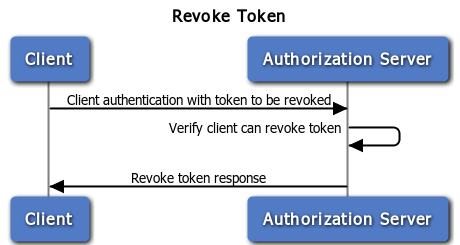
The endpoint for revoke token requests is as follows:
https://<API Gateway>:8089/api/oauth/revoke
The token to be revoked should be sent to the revoke token endpoint in an HTTP
POST with the following parameter:
| Parameter | Description |
|---|---|
|
|
Required. A token to be revoked (for example,
|
The following is an example POST request:
POST /api/oauth/revoke HTTP/1.1 Content-Type: application/x-www-form-urlencoded; charset=UTF-8 Host: 192.168.0.48:8080 Authorization: Basic U2FtcGxlQ29uZmlkZW50aWFsQXBwOjY4MDhkNGI2LWVmMDktNGIwZC04ZjI4LT NiMDVkYTljNDhlYw==token=4eclEUX1N6oVIOoZBbaDTI977SV3T9KqJ3ayOvs4gqhGA4
Running the sample client
The following Jython sample client creates a token revoke request to the Authorization Server:
INSTALL_DIR/samples/scripts/oauth/revoke_token.py
To run the sample, open a shell prompt at INSTALL_DIR/samples/scripts,
and execute the following command:
> run oauth/revoke_token.py
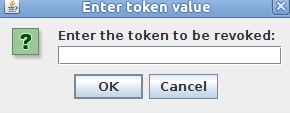
When the Authorization Server receives the token revocation request, it first validates the client credentials and verifies whether the client is authorized to revoke the particular token based on the client identity.
![[Note]](../common_oracle/images/admon/note.png) |
Note |
|---|---|
|
Only the client that was issued the token can revoke it. |
The Authorization Server decides whether the token is an access token or a refresh token:
-
If it is an access token, this token is revoked.
-
If it is a refresh token, all access tokens issued for the refresh token are invalidated, and the refresh token is revoked.
Response codes
The following HTTP status response codes are returned:
-
HTTP 200 if processing is successful.
-
HTTP 401 if client authentication failed.
-
HTTP 403 if the client is not authorized to revoke the token.
The following is an example response:
Token to be revoked: 3eXnUZzkODNGb9D94Qk5XhiV4W4gu9muZ56VAYoZiot4WNhIZ72D3 Revoking token............... Response from revoke token request is: 200 Successfully revoked token
Further information
For details on the API Gateway filter that supports this flow, see Revoke a Token.
You can use the Token Info Service to validate that an access token
issued by the API Gateway. A request to the tokenInfo service is an HTTP
GET request for information in a specified OAuth 2.0 access token.
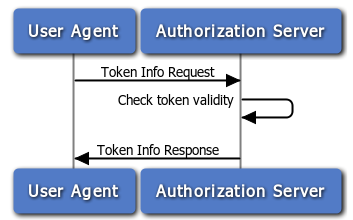
The endpoint for the token information service is as follows:
https://<apigateway>:8089/api/oauth/tokeninfo
Getting information about a token from the Authorization Server only requires
a GET request to the tokeninfo endpoint. For example:
GET /api/oauth/tokeninfo HTTP/1.1 Host: 192.168.0.48:8080 access_token=4eclEUX1N6oVIOoZBbaDTI977SV3T9KqJ3ayOvs4gqhGA4
This request includes the following parameter:
| Parameter | Description |
|---|---|
|
|
Required. A token that you want information about (for example:
|
The following example uses this parameter:
https://apigateway/api/oauth/tokeninfo?access_token=4eclEUX1N6oVIOoZBba DTI977SV3T9KqJ3ayOvs4gqhGA4
Running the sample client
The following Jython sample client creates a token revoke request to the Authorization Server:
INSTALL_DIR/samples/scripts/oauth/token_info.py
To run the sample, open a shell prompt at INSTALL_DIR/samples/scripts,
and execute the following command:
> run oauth/token_info.py
This displays the following dialog:
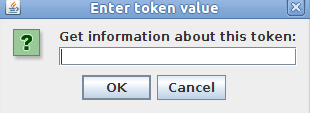
When the Authorization Server receives the Token Info request, it first ensures the token is in its cache (EhCache or Database), and ensures the token is valid and has not expired.
The following is an example response:
Get token info for this token: BcYGjPOQSCrtbEc1F0ag8zf6OT9rCaMLiI1dYjFLT5zhxz3x5ScrdN Response from token info request is: 200 **********************TOKEN INFO RESPONSE*********************************** Token audience received from authorization server: SampleConfidentialApp Scopes user consented to: https://localhost:8090/auth/userinfo.email Token expiry time: 3566 User id : admin ******************************************************************************
Response codes
The following HTTP Status codes are returned:
-
200 if processing is successful
-
400 on failure
The response is sent back as a JSON message. For example:
{
"audience" : "SampleConfidentialApp",
"user_id" : "admin",
"scope" : "https://localhost:8090/auth/userinfo.email",
"expires_in" : 2518
}
You can get additional information about the access token using message attributes. For more details, see the section called “Querying OAuth 2.0 Message Attributes”.
Further information
For details on the API Gateway filter that supports this flow, see OAuth Access Token Information.

